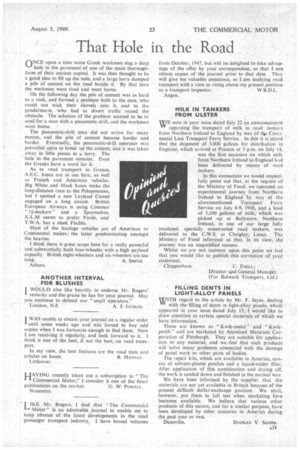That Hole in the Road
Page 55

If you've noticed an error in this article please click here to report it so we can fix it.
(-INCE upon a time some Greek workmen dug a deep
hole in the pavement of one of the main thoroughfares of their ancient capital It was then thought to be a good idea to fill up the hole, and a large lorry dumped a pile of cement on the road beside it. By that time the workmen were tired and went home.
• On the following day the pile of cement was as hard as a rock, and formed a problem both to the men, who could not stick their shovels into it, and to the gendai-rnerie, who had to divert traffic round the obstacle. The solution of the problem seemed to be to send for a man with a pneumatic drill, and the workmen went home. '
The Pneumatic-drill man did not arrive for many moons, and the pile of cement became harder and harder. Eventually, the pneumatic-drill operator was prevailed upon to break up the cement, and it was taken
• away. in little pieces in a lorry. The hole in the pavement remains. Even the Greeks have a word for it.
As to road transport in Greece, A.E.C. buses are in use here, as well as French and American vehicles.
Big White and Mack buses make the long-distance runs to the Peloponnese, but I spotted a new Leyland Comet engaged on a long circuit. British European Airways is using Commer li-deckers" and a Spurmobus. K.L.M seems to prefer Fords, and T.W.A.. has a sleek Flxible.
Most of the haulage vehicles are of American or Continental makes, the latter predominating amongst the heavies.
I think there is great scope here for a really powerful and substantially built four-wheeler with a high payload capacity. British eight-wheelers and six-wheelers are too
long. A. Smrrit. Athens.
ANOTHER INTERVAL , FOR BLUSHES
I WOULD also like heartily to endorse Mr. Rogers' remarks and the .praise he has for your journal. May you continue to defend our "small operators."
London, N.8. A. J. -INGRAM.
I WAS unable to obtain your journal on a regular order
until some weeks ago and wa-s forced to buy odd copies when I was fortunate enough to find them. Now I am receiving it regularly, and look forward to it. I think it one of the best, if not the best, on road transport.
In my view, the best features are the road tests and articles on buses. R. HANNAY. Littleover.
'WAVING recently taken out a subscription to " The I 1 Commercial Motor," I consider it one of the finest
publications on the market. G. W. Pownt.L. Nuneaton.
I IKE Mr. Rogers, I find that "The Commercial Motor" is an admirable journal to enable me to keep abreast of the latest developments in the road passenger transport industry: I have bound volumes
from October, 1947, but will he delighted to take advantage of the offer by your correspondent, so that I can obtain copies of the journal prior to that date. They will give me valuable assistance, as I am studying road transport with a view to rising above my.present position as a transport inspector. W.B.D.L. Angus.
MILK IN TANKERS FROM ULSTER WE note in your issue dated July 22 an announcement Yr regarding the transport of milk in roadtankers from Northern Ireland to England by way of die Continental Line Transport Ferry Service. In this it is stated that the shipment of 3,000 gallons for distribution in England, which arrived at Preston at 3 p.m. on July 14, was the first occasion on which milk from Northern Ireland to England had been delivered by means of road tankers.
In this connection we would respectfully point out that, at the request of the Ministry of Food, we operated an experimental journey from Northern Ireland to England by way of the aforementioned Transport Ferry Service on July 8-9, 1948, and a load of 3,100 gallons of milk,which was picked up at Ballynure, Northern Ireland, in one of our large fully insulated, specially constructed road tankers, was delivered to the C.W.S. at Chaigley, Lancs. The Ministry of Food informed Us that, in its view, the journey was an unqualified success.
Whilst we are not insistent upon this point we feel that you would like to publish this correction of your statement.
Chippen ha m. C. EXELI„
Director a,nd General Manager. (For Bulwark Transport, Ltd ) ' FILLING DENTS IN LIGHT-ALLOY PANELS WITH regard to the article by Mr. F. Teyes, dealing " with the filling of dents in light-alloy panels, which ' appeared in your issue dated July 15,1 would like to draw attention to certain special materials of which we have information.
These are known as " Kwik-metal " and " Kwikpatch and are marketed by Atomised Materials Corporation of Pittsburgh. They are suitable for application to any material, and we.feel that such products will solve many problems connected with the damage of panel work or other parts of bodies.
The repair kits, which are available in America, consist of solvent-plastic patches and a liquid-solder filler. After application of this combination and drying off, the work is sanded down and finished in the normal way.
We have been informed by the supplier that the materials are not yet available in Britain because of the present difficult dollar-exchange position. We shall, however, put them to full test when marketing here becomes available. We believe that various other products of this nature, and for a similar purpose, have been developed by other concerns in America during the past year or two.
Durisville. STANLEY V. SANDS.
























































































